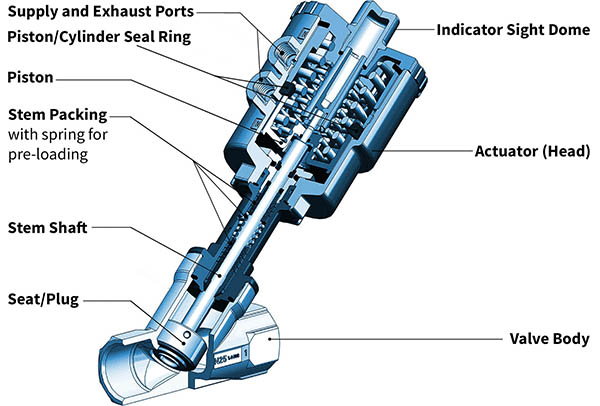Annular Piston Valve on:
[Wikipedia]
[Google]
[Amazon]
{{Unreferenced, date=June 2019, bot=noref (GreenC bot)
 An angle seat piston valve is a pneumatically-controlled
An angle seat piston valve is a pneumatically-controlled
 An angle seat piston valve is a pneumatically-controlled
An angle seat piston valve is a pneumatically-controlled valve
A valve is a device or natural object that regulates, directs or controls the flow of a fluid (gases, liquids, fluidized solids, or slurries) by opening, closing, or partially obstructing various passageways. Valves are technically fittings ...
with a piston actuator
An actuator is a component of a machine that is responsible for moving and controlling a mechanism or system, for example by opening a valve. In simple terms, it is a "mover".
An actuator requires a control device (controlled by control signal) a ...
providing linear actuation to lift a seal off its seat. The seat is set at an angle to provide the maximum possible flow when unseated. Angle seat piston valves are particularly suited to applications where high temperatures and large flow rates are required, such as steam or water. When used in reverse some models of angle seat piston valve will eliminate water hammer when operated.
Operation
Pneumatic valves are operated by a pilot medium under pressure, usuallycompressed air
Compressed air is air kept under a pressure that is greater than atmospheric pressure. Compressed air is an important medium for transfer of energy in industrial processes, and is used for power tools such as air hammers, drills, wrenches, and o ...
but also oil or water.
The valve is equipped with a pneumatic actuator supplied by a three-way solenoid valve. The pressure of the pilot medium enters the actuator cylinder and acts on the piston, which allows the seal to open or to close through the stem. The return of the seal into its rest position is usually achieved by a return spring that can be found in the pneumatic actuator.
In the double-acting configuration, there is no return spring and the pilot medium is used both for opening and for closing the valve.
A red indicator becomes visible through the sight dome that is found on the top of the actuator when the valve is in the open position.
The pressure range depends on the pressure of the pilot medium and the controlled medium and on the direction of the flow, but also on construction parameters of the valve, such as the diameter of the orifice, the diameter of the actuator cylinder and the spring force.
See also
*Piston valve
A "piston valve" is a device used to control the motion of a fluid along a tube or pipe by means of the linear motion of a piston within a chamber or cylinder.
Examples of piston valves are:
* The valves used in many brass instruments
* The va ...
Valves